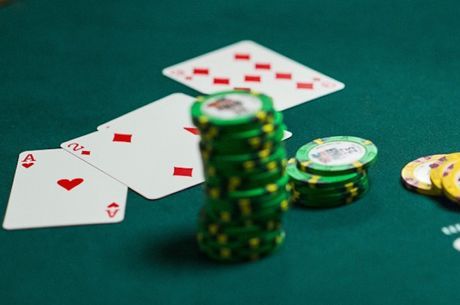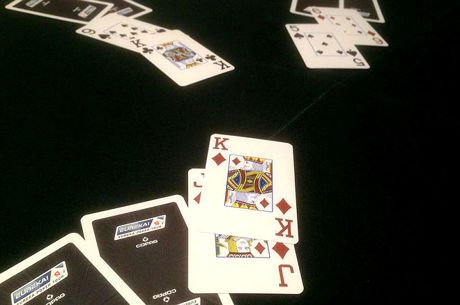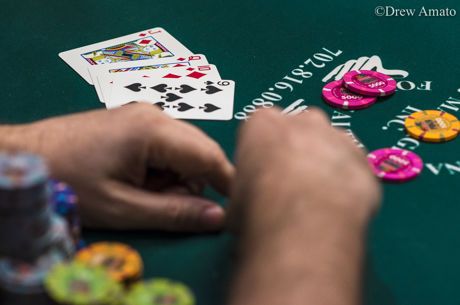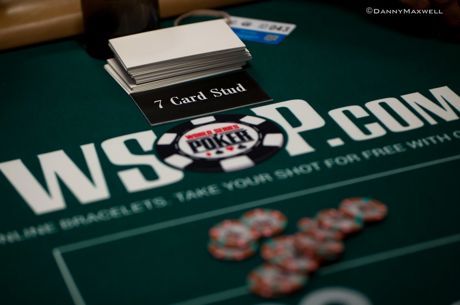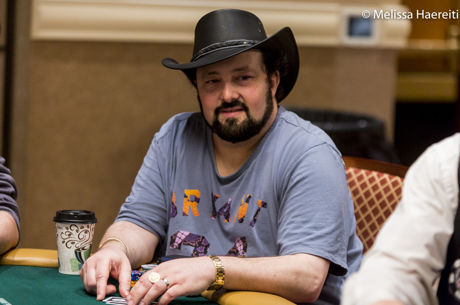Stud Poker Strategy - Bluffing, Part 3

Let's take a look at some actual hands and consider their bluffing potential.
You have (8c-7c) As. You are in early position. You see around the table the following hands, starting on your left.
Ks
9c
Jd
8d
Kc
3c
So the 3c is to your immediate right. He brings in the bet for $3.00 in this $10/20 game. You don't know much about the other players except that there are usually at least a few people who call a raise on Third Street and see their fourth card. The pot is rarely conceded at that stage in the betting.
Should you raise with you As representing a pair of Aces in the hope of winning the antes and the bring in?
Your first consideration needs to be mathematical. How much will the raise cost you; and what are you going to win if you succeed?
The raise, obviously, costs the amount of the small bet: $10. There will be $1 per player in antes plus the $3.00 bring in. That's $10 too. So it's an even money bet. For every successful bluff you'll win $10 for every $10 bet.
Let's look at the eight factors for a bluff from an earlier article to see if this makes sense.
1. The quality of your opponent.
We really don't know much about the quality of the opposition. But it's fair to say that if a number of players call a raise on Third Street that many of them are not very tight.
That being the case, your chance of success with a bluff in early position, before anyone has indicated whether they have a strong or weak hand with their betting action, is reduced.
2. Your image
Again, you really don't have much intelligence on this matter yet. It's early in the game and you haven't yet folded a long string of hands in a row. You don't give these players too much credit for knowing how you play. So it's unlikely that they've yet pegged you as a very tight player. This also diminishes the possibility that they will fold - hurting your ability to bluff.
3. The prior betting action
This is Third Street so there's been no prior betting action on the round. This doesn't apply.
4. The cards that are exposed
On the one hand, you see two Kings. So you may be thinking that it's less likely that either of them has a pair of Kings - and therefore more likely that they'll fold. But while it's true that each of the player is less likely to have a pair than if no other Kings were exposed - aggregately it's MORE likely that either one of them has a pair of Kings.
5. The overall quality of your hand.
Your hand is really bad. Though you have an Ace scare card, you have no pair and no other high cards. Your 2-flush adds nothing since there are three others of that suit that are out - and you have medium suited cards. The 2-straight is also practically valueless since two of the cards to make your straight are also out. Your pretty worthless holding means that you're going to have to win as a bluff if you're going to win the hand.
6. Your opponent's likely hand.
You really have very little intelligence on your opponent's likely hand - nothing except their door card. The one thing you do know is that unless someone has trips, you are representing the best hand out there. That's a plus. You want to avoid situations where you are bluffing - but an opponent or opponents can beat the hand you're representing.
7. How many people are in the hand.
Right now, all of them are in the hand - making your bluff less likely to succeed. That's why it is often better to try an ante steal from late position after everyone in front of you has folded.
8. The money in the pot.
There are only the antes and the bring-in - making this a tiny pot right now. Other players are less likely to fight over it. This gives your bluff a greater chance of success. But since it's so small, it also makes it less worth winning.
Summary
Overall then, we'd have to conclude that your bluff only has the slimmest chance of success in this situation. Your chances certainly aren't 50:50 or better - what you'd need for this bluff attempt to make sense. So don't try it here.
Of course, you're not going to spend the time to deeply think about each of these factors every time you contemplate a bluff. You'll use a mental shorthand. But go through them again and make sure you realize why this was a bad bluffing situation.
Now consider something slightly different. You've been playing at the table a while. You have gotten hardly any cards for the past hour - folding nearly every time. Your opponents turn out to be relatively tight and pretty sophisticated. The one exception to this is the player to your immediate left who tends to be very aggressive and loose. He doesn't play every hand - but he often seems to try to steal the antes.
You have the (4s 4d)As. The other hands are:
5c
9d
Kd
8h
Kh
3c
The 3c again brings it in.
How is this situation different from the prior one? Do you see why your chances of winning as a bluff have improved? The pot is giving you the same even odds. But because your image is tighter, because your opponents tend to be tighter, and because your hand is actually quite a bit better, the bluff may make more sense. Also, the one twist I threw in about the loose aggressive player, also tends to work in your favor. He has a low door card. It's unlikely that he'll play this hand without at least a scare card from such early position - especially when a perceived rock like you is already raising.
You're much more likely to win this ante-steal attempt.
Next time: semi-bluffing.
Play Stud with WSOP bracelet winner Perry Friedman nearly every night atFull Tilt





